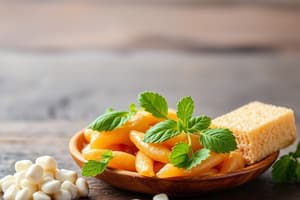Podcast
Questions and Answers
What is the main function of enzymes in cells?
What is the main function of enzymes in cells?
- Store oxygen and fats
- Facilitate chemical reactions (correct)
- Defend against infections
- Regulate metabolic processes
Which category of proteins is responsible for moving substances across cell membranes?
Which category of proteins is responsible for moving substances across cell membranes?
- Membrane proteins (correct)
- Globular proteins
- Hormones
- Fibrous proteins
Where are membrane proteins primarily located?
Where are membrane proteins primarily located?
- In cell membranes (correct)
- In bones, tendons, and ligaments
- In cell nucleus
- In hair, nails, and skin
Which food source is NOT mentioned as a significant protein provider?
Which food source is NOT mentioned as a significant protein provider?
What is the primary function of defensive proteins like antibodies?
What is the primary function of defensive proteins like antibodies?
Which statement is true about fibrous proteins?
Which statement is true about fibrous proteins?
What are the building blocks of proteins?
What are the building blocks of proteins?
Where does the primary site of protein digestion occur?
Where does the primary site of protein digestion occur?
What enzymes in the small intestine are responsible for breaking down proteins into amino acids?
What enzymes in the small intestine are responsible for breaking down proteins into amino acids?
Which function do proteins NOT perform?
Which function do proteins NOT perform?
Which of the following is NOT a type of protein according to the text?
Which of the following is NOT a type of protein according to the text?
Where do proteins often form the scaffold or framework, providing support and strength?
Where do proteins often form the scaffold or framework, providing support and strength?
Study Notes
Proteins: Building Blocks of Life and Beyond
Proteins are a fundamental component of life, making up a significant portion of cells and serving multiple essential functions. In this article, we'll delve into the structure, digestion, functions, and various types of proteins, exploring how they sustain and enrich our lives.
Structure
Proteins are made up of building blocks called amino acids, which are linked together in a linear chain through peptide bonds. These chains can then fold into unique, three-dimensional shapes, dictated by the specific amino acids present and their arrangement. These shapes enable proteins to perform their diverse roles within cells and the body.
Digestion
Proteins are broken down during digestion into their constituent amino acids, which can then be reused by the body. The process of breaking down proteins begins in the stomach, where they are exposed to enzymes such as pepsin. The primary site of protein digestion, however, is the small intestine, where pancreatic enzymes, such as trypsin and chymotrypsin, and brush border enzymes, such as dipeptidases and aminopeptidases, work together to break the proteins down into smaller peptides and amino acids, which are then absorbed into the bloodstream.
Functions
Proteins perform a wide variety of functions, including:
- Structural components: Proteins often form the scaffold or framework of cells and tissues, providing support and strength.
- Catalytic functions: Enzymes, a type of protein, facilitate chemical reactions within cells to enable metabolic processes and energy production.
- Transport and storage: Proteins are responsible for moving substances across cell membranes and storing substances such as oxygen (hemoglobin) and fats (lipoproteins).
- Regulatory functions: Proteins regulate the activity of cells and organs, such as hormones like insulin and growth factors.
- Defensive functions: Antibodies, a type of protein, are part of the immune system and help the body fight off infections and diseases.
Types of Proteins
Proteins are classified into several categories based on their structure and function:
- Fibrous proteins: These proteins have a linear, rod-like structure and are typically insoluble in water. Examples include keratin (found in hair, nails, and skin) and collagen (found in bones, tendons, and ligaments).
- Globular proteins: These proteins have a spherical shape and are generally soluble in water. Examples include enzymes, hormones, and antibodies.
- Membrane proteins: These proteins are embedded in cell membranes, where they help maintain cell structure, transport substances, and carry signals across the membrane.
Sources
Proteins are obtained from a variety of food sources, including:
- Animal products: Meat, fish, poultry, dairy products, and eggs are rich in proteins.
- Plant products: Pulses (beans, lentils, and peas), nuts, seeds, whole grains, and certain vegetables contain significant amounts of protein.
- Supplements: Protein powder and other supplements are available for those who require additional protein in their diet.
In conclusion, proteins are essential to life and have diverse roles within cells and the body. They are obtained from a wide range of food sources, and their digestion, structure, and function are well understood. By exploring the nuances of these topics, we can appreciate the importance and complexity of proteins in our daily lives.
Studying That Suits You
Use AI to generate personalized quizzes and flashcards to suit your learning preferences.
Description
Explore the fundamental components of proteins, from their structure and functions to various types and dietary sources. Learn about how proteins are broken down during digestion, their diverse roles in cells and the body, and where to obtain them from food sources and supplements.




